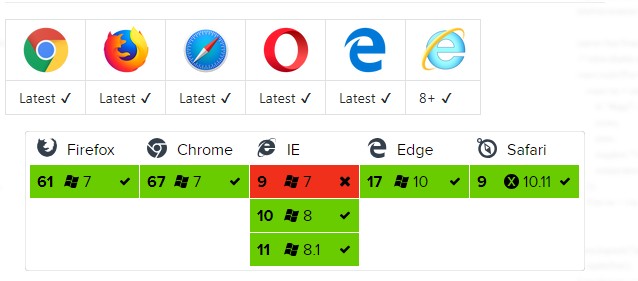vue axios 攻略
Posted 云上丶无忧
tags:
篇首语:本文由小常识网(cha138.com)小编为大家整理,主要介绍了vue axios 攻略相关的知识,希望对你有一定的参考价值。
Axios 是一个基于 promise 的 HTTP 库,可以用在浏览器和 node.js 中。
特点:
- 从浏览器中创建 XMLHttpRequest
- 从 node.js 发出 http 请求
- 支持 Promise API
- 拦截请求和响应
- 转换请求和响应数据
- 取消请求
- 自动转换JSON数据
- 客户端支持防止 CSRF/XSRF
兼容性:

server.js配置
以一个豆瓣接口为例:
app.use(\'/v2\',httpProxyMiddleware({
target:\'https://api.douban.com\',
changeOrigin:true
}));
安装:
使用npm
$ npm install axiosbower安装
$ bower install axios使用cdn
<script src="https://unpkg.com/axios/dist/axios.min.js"></script>例子:
执行GET请求
// 为给定 ID 的 user 创建请求
axios.get(\'/user?ID=12345\')
.then(function (response) {
console.log(response);
})
.catch(function (error) {
console.log(error);
});
// 可选地,上面的请求可以这样做
axios.get(\'/user\', {
params: {
ID: 12345
}
})
.then(function (response) {
console.log(response);
})
.catch(function (error) {
console.log(error);
}); 执行POST
axios.post(\'/user\', {
firstName: \'Fred\',
lastName: \'Flintstone\'
})
.then(function (response) {
console.log(response);
})
.catch(function (error) {
console.log(error);
});
执行多个并发请求
function getUserAccount() {
return axios.get(\'/user/12345\');
}
function getUserPermissions() {
return axios.get(\'/user/12345/permissions\');
}
axios.all([getUserAccount(), getUserPermissions()])
.then(axios.spread(function (acct, perms) {
// 两个请求现在都执行完成
}));axios请求本地json数据
js部分
<script type="text/javascript">
import axios from \'axios\'
export default{
data() {
return {
contacts: []
}},
created() {
axios.get(\'static/data.json\').then(response =>
{
this.contacts = response.data.contacts;
//这里打印出结果是undifine
console.log(this.contacts)
});
},
}
</script>axios API
可以通过axios传递相关配置来创建请求
axios(config)
// 发送 POST 请求
axios({
method: \'post\',
url: \'/user/12345\',
data: {
firstName: \'Fred\',
lastName: \'Flintstone\'
}
});axios(url[, config])
// 发送 GET 请求(默认的方法)
axios(\'/user/12345\');请求方法的别名
axios.request(config)
axios.get(url[, config])
axios.delete(url[, config])
axios.head(url[, config])
axios.post(url[, data[, config]])
axios.put(url[, data[, config]])
axios.patch(url[, data[, config]])
notice:在使用别名方法时, url、method、data 这些属性都不必在配置中指定。
并发:
处理并发请求对的函数
axios.all(iterable)
axios.spread(callback)
创建实例
可以使用自定义配置新建一个 axios 实例
axios.create([config])
var instance = axios.create({
baseURL: \'https://some-domain.com/api/\',
timeout: 1000,
headers: {\'X-Custom-Header\': \'foobar\'}
});
实例方法:
以下是可用的实例方法。指定的配置将与实例的配置合并
axios#request(config)
axios#get(url[, config])
axios#delete(url[, config])
axios#head(url[, config])
axios#post(url[, data[, config]])
axios#put(url[, data[, config]])
axios#patch(url[, data[, config]])
请求配置
这些是创建请求时可以用的配置选项。只有 url 是必需的。如果没有指定 method,请求将默认使用 get 方法。
{
// `url` 是用于请求的服务器 URL
url: \'/user\',
// `method` 是创建请求时使用的方法
method: \'get\', // 默认是 get
// `baseURL` 将自动加在 `url` 前面,除非 `url` 是一个绝对 URL。
// 它可以通过设置一个 `baseURL` 便于为 axios 实例的方法传递相对 URL
baseURL: \'https://some-domain.com/api/\',
// `transformRequest` 允许在向服务器发送前,修改请求数据
// 只能用在 \'PUT\', \'POST\' 和 \'PATCH\' 这几个请求方法
// 后面数组中的函数必须返回一个字符串,或 ArrayBuffer,或 Stream
transformRequest: [function (data) {
// 对 data 进行任意转换处理
return data;
}],
// `transformResponse` 在传递给 then/catch 前,允许修改响应数据
transformResponse: [function (data) {
// 对 data 进行任意转换处理
return data;
}],
// `headers` 是即将被发送的自定义请求头
headers: {\'X-Requested-With\': \'XMLHttpRequest\'},
// `params` 是即将与请求一起发送的 URL 参数
// 必须是一个无格式对象(plain object)或 URLSearchParams 对象
params: {
ID: 12345
},
// `paramsSerializer` 是一个负责 `params` 序列化的函数
// (e.g. https://www.npmjs.com/package/qs, http://api.jquery.com/jquery.param/)
paramsSerializer: function(params) {
return Qs.stringify(params, {arrayFormat: \'brackets\'})
},
// `data` 是作为请求主体被发送的数据
// 只适用于这些请求方法 \'PUT\', \'POST\', 和 \'PATCH\'
// 在没有设置 `transformRequest` 时,必须是以下类型之一:
// - string, plain object, ArrayBuffer, ArrayBufferView, URLSearchParams
// - 浏览器专属:FormData, File, Blob
// - Node 专属: Stream
data: {
firstName: \'Fred\'
},
// `timeout` 指定请求超时的毫秒数(0 表示无超时时间)
// 如果请求话费了超过 `timeout` 的时间,请求将被中断
timeout: 1000,
// `withCredentials` 表示跨域请求时是否需要使用凭证
withCredentials: false, // 默认的
// `adapter` 允许自定义处理请求,以使测试更轻松
// 返回一个 promise 并应用一个有效的响应 (查阅 [response docs](#response-api)).
adapter: function (config) {
/* ... */
},
// `auth` 表示应该使用 HTTP 基础验证,并提供凭据
// 这将设置一个 `Authorization` 头,覆写掉现有的任意使用 `headers` 设置的自定义 `Authorization`头
auth: {
username: \'janedoe\',
password: \'s00pers3cret\'
},
// `responseType` 表示服务器响应的数据类型,可以是 \'arraybuffer\', \'blob\', \'document\', \'json\', \'text\', \'stream\'
responseType: \'json\', // 默认的
// `xsrfCookieName` 是用作 xsrf token 的值的cookie的名称
xsrfCookieName: \'XSRF-TOKEN\', // default
// `xsrfHeaderName` 是承载 xsrf token 的值的 HTTP 头的名称
xsrfHeaderName: \'X-XSRF-TOKEN\', // 默认的
// `onUploadProgress` 允许为上传处理进度事件
onUploadProgress: function (progressEvent) {
// 对原生进度事件的处理
},
// `onDownloadProgress` 允许为下载处理进度事件
onDownloadProgress: function (progressEvent) {
// 对原生进度事件的处理
},
// `maxContentLength` 定义允许的响应内容的最大尺寸
maxContentLength: 2000,
// `validateStatus` 定义对于给定的HTTP 响应状态码是 resolve 或 reject promise 。如果 `validateStatus` 返回 `true` (或者设置为 `null` 或 `undefined`),promise 将被 resolve; 否则,promise 将被 rejecte
validateStatus: function (status) {
return status >= 200 && status < 300; // 默认的
},
// `maxRedirects` 定义在 node.js 中 follow 的最大重定向数目
// 如果设置为0,将不会 follow 任何重定向
maxRedirects: 5, // 默认的
// `httpAgent` 和 `httpsAgent` 分别在 node.js 中用于定义在执行 http 和 https 时使用的自定义代理。允许像这样配置选项:
// `keepAlive` 默认没有启用
httpAgent: new http.Agent({ keepAlive: true }),
httpsAgent: new https.Agent({ keepAlive: true }),
// \'proxy\' 定义代理服务器的主机名称和端口
// `auth` 表示 HTTP 基础验证应当用于连接代理,并提供凭据
// 这将会设置一个 `Proxy-Authorization` 头,覆写掉已有的通过使用 `header` 设置的自定义 `Proxy-Authorization` 头。
proxy: {
host: \'127.0.0.1\',
port: 9000,
auth: : {
username: \'mikeymike\',
password: \'rapunz3l\'
}
},
// `cancelToken` 指定用于取消请求的 cancel token
// (查看后面的 Cancellation 这节了解更多)
cancelToken: new CancelToken(function (cancel) {
})
}响应结构
某个请求的响应包含以下信息
{
// `data` 由服务器提供的响应
data: {},
// `status` 来自服务器响应的 HTTP 状态码
status: 200,
// `statusText` 来自服务器响应的 HTTP 状态信息
statusText: \'OK\',
// `headers` 服务器响应的头
headers: {},
// `config` 是为请求提供的配置信息
config: {}
}
使用 then 时,你将接收下面这样的响应:
axios.get(\'/user/12345\')
.then(function(response) {
console.log(response.data);
console.log(response.status);
console.log(response.statusText);
console.log(response.headers);
console.log(response.config);
});在使用 catch 时,或传递 rejection callback 作为 then 的第二个参数时,响应可以通过 error 对象可被使用,正如在错误处理这一节所讲。
配置的默认值,/defaults
你可以指定将被用在各个请求的配置默认值
全局的默认axios值
axios.defaults.baseURL = \'https://api.example.com\';
axios.defaults.headers.common[\'Authorization\'] = AUTH_TOKEN;
axios.defaults.headers.post[\'Content-Type\'] = \'application/x-www-form-urlencoded\';自定义实例的默认值
// 创建实例时设置配置的默认值
var instance = axios.create({
baseURL: \'https://api.example.com\'
});
// 在实例已创建后修改默认值
instance.defaults.headers.common[\'Authorization\'] = AUTH_TOKEN;配置的优先顺序
配置会以一个优先顺序进行合并。这个顺序是:在 lib/defaults.js 找到的库的默认值,然后是实例的 defaults 属性,最后是请求的 config 参数。后者将优先于前者。这里是一个例子:
// 使用由库提供的配置的默认值来创建实例
// 此时超时配置的默认值是 `0`
var instance = axios.create();
// 覆写库的超时默认值
// 现在,在超时前,所有请求都会等待 2.5 秒
instance.defaults.timeout = 2500;
// 为已知需要花费很长时间的请求覆写超时设置
instance.get(\'/longRequest\', {
timeout: 5000
});
拦截器
在请求或响应被 then 或 catch 处理前拦截它们。
// 添加请求拦截器
axios.interceptors.request.use(